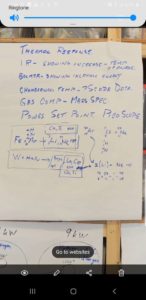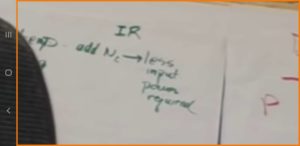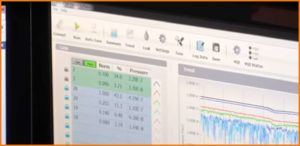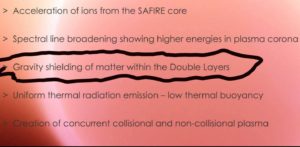The following post has been submitted by ECW reader “Director”
All Revealed: The SAFIRE Project and Self Organizing Plasmas (EVOs) FAQ
By Director
DISCLAIMER: This FAQ is not sanctioned by The SAFIRE Project or Aureon Energy LTD. It consists of publicly available information and my own personal opinions after extensive research. Do NOT consider any of the following to be official answers from The SAFIRE Project or Aureon Energy LTD
1) What is The SAFIRE Project and Aureon Energy LTD.?
Go to their webpages and find out – they provide a full account of their history and progress to date.
2) What’s the significance of their reactor: haven’t people been playing with glow plasma for a hundred years?
The SAFIRE Project utilizes a specific plasma regime in which ions and electrons can self organize into specific configurations that can produce a wide range of anomalies including but not limited to excess energy in many forms (heat has been discussed the most) and transmutation of elements (signifying some sort of nuclear process is taking place).
3) So there’s a phase during an electrical discharge in which plasma self organizes?
Absolutely. During what’s called the “negative resistance” or “negative differential resistance” regime of a plasma discharge – just before a true arc discharge – plasma self organizes into what is referred to by many terms including “complex space charge configuration” or macro-scale EVO. This structure can be composed of one or more (quite often multiple) inner cores of positive ions and outer shells or membranes of electrons (possibly in an exotic superconducting state although this has yet to be confirmed). When many of these “double layers” of electrons on one side and positive ions on another are nested within one another, they produce the beautiful large plasma formations in The SAFIRE Project’s videos.
4) Negative resistance regime… isn’t that impossible? Wouldn’t a negative resistance produce free electrical energy and therefore violate all laws of thermodynamics?
The negative resistance regime represents a proven and repeated (thousands of times) condition in which the current and voltage relationship of the plasma is flip flopped, hence the electrical properties are reverse that of what would exist in an ordinary electrical conductor – such as a length of copper wire. Moreover, the complex space charge configuration or plasma ball composed of one or more double layers survives by absorbing energy from the environment and converting it into electrical power to sustain its structure. In this manner, this self organizing formation both stores energy like a capacitor and behaves as a thermoelectric converter. Due to this unique behavior, from a certain point of view, it could be considered to exhibit a true negative resistance.
5) Can you tell me a little bit more about what happens when an electrical discharge goes through the negative resistance regime?
First of all, it should be pointed out that every electrical discharge goes through this regime on the way towards an arc discharge – even if only for the briefest of moments. For the most part, you wouldn’t even notice this regime existed, because once in the negative resistance regime the electrical resistance of a discharge drops dramatically allowing for an incredibly rapid transition to a true arc discharge. This is why the negative resistance regime is designed out of many systems and is only practically utilized in a few technologies. For example, certain types of lighting use ballasts (electrical resistors) to keep the current going through a plasma within the “glow discharge” below the value that would make it transition to the negative resistance regime. In these systems if the resistance were to fail, the current would soar, moving immediately to a true arc discharge, and burning out the bulb and/or power supply. Moreover, there are specific characteristics of a plasma in the negative resistance regime that can wreck havoc on electrical systems – such as sudden high power transient discharges that can occur when a macro-EVO or complex space charge configuration (acting like a capacitor) discharges its stored energy within a very sudden, short duration of time.
6) What makes the current climb so quickly during the negative resistance regime?
Whenever a discharge move through the negative resistance regime by definition a complex space charge configuration must form. The large surface area of the self organizing plasma collects electrons making the resistance drop – the larger or more plentiful the double layers the greater the conductivity of the plasma becomes. These two processes sort of go hand in hand. There is literature available that details the exact processes that are taking place such as varying diffusion rates of ions and electrons (due to their differing masses) that help make the plasma self organize. However, unless you really want to dig deep, which the author of this document hopes people will do, the basics are enough for now.

7) What is an EVO?
Kenneth Radford Shoulders in collaboration with Dr. Harold E. Puthoff started a research project in the early 1980’s to investigate what Kenneth Shoulders eventually named EVOs or Exotic Vacuum Objects. These were very small versions (microns in size) of the far larger self organizing plasmas or macro-scale EVOs (inches in diameter) that The SAFIRE Project currently creates in their reactor. However, instead of being formed around a central spherical anode between two flat circular cathodes, they were ejected off a sharp, pointy cathode tip towards an anode or target plate. Basically, they were the result of him rapidly pulsing his cathode so that the negative resistance regime was achieved for only a brief moment. Out of the plasma “soup” of positive ions, electrons, and metal nano-particles that would be the result of the transient pulse, what he called an EVO would form. He quickly realized that they had numerous anomalous properties, including but not limited to the ability to transmute elements where they impacted (such as target plates in front of the anode), produce some sort of field configuration that negated a huge fraction of their mass and inertia (allowing them to be accelerated to high speeds with little input energy), split apart and recombine, follow tracks or guides (such as groves in dielectric materials like aluminum oxide), produce electromagnetic pulses upon destruction, etc.
8) I’ve never heard of EVOs before. What else can you tell me about them?
A few important facts are as follows. First, they are ubiquitous in nature. For example, when you rub your socks on the carpet and touch a metal door knob and produce a spark an EVO is created for the briefest of moments. Secondly, they can scale to all sizes ranging from nano-scale EVOs within hydrogen embrittled metal lattices undergoing fracto-emission, micron-scale EVOs from his sharped cathodes, naked eye scale such as in the SAFIRE reactor, and even larger “ball lightning.” Some speculate that the scale can even extend even further to the point of stars having similar properties, such as the proponents of The Electric Universe Theory. Thirdly, they can exist either transiently (spark discharges) or for long periods of time (such as in the SAFIRE Project reactor. Fourthly, there are a multitude of different ways to produce them: fracturing various materials (fracto-emission), producing cavitation bubbles with ultrasound, generating spark discharges (briefly going through the negative resistance regime), or maintaining a plasma discharge within the negative resistance regime for an extended period of time. This last method is the likely solution of how to scale up Kenneth R. Shoulders technology for energy production via nuclear and potentially other processes.
9) Whatever happened to Kenneth R. Shoulders?
After several years of experimenting with EVOs and finding multiple ways to produce them, he filed multiple patent applications only to be warned that the government was going to seize his technology via the excuse of national security (utilizing the same legal mechanisms that are used to seize many technologies every single year). He responded by hurriedly composing a very rare book he self published (printing only an extremely small number of copies) titled, “EV – A Tale of Discovery.” Upon learning about his defiant act, the government demanded he provide the names and addresses of everyone whom he sent a copy. He responded by telling them, “the computer at the list.” This apparently was enough to make them give up and allow his patents to go through. However, at some point after this time, there was a little understood separation that developed between him and his associates, namely Harold Puthoff and his employees at Earthtech. Simply put, their research collaboration ended. But he went on to publish a long series of essays and papers on the internet which still exist if you know where to look. Up until the last years of his life, Kenneth Shoulders was a strong proponent of EVO research. However, word has spread among certain circles that when he was close to death he asked that all his writings be removed from the internet because of the danger which could go along with his technology if used for nefarious purposes. This didn’t happen and his writings are still available, although they are more difficult to find.
10) Are you saying that The SAFIRE Project is utilizing EVO technology?
Yes. That is crystal clear to the author of this FAQ. However, they have NOT referred to their technology as being related to EVOs or have ever publicly referenced EVOs. But the connection is obvious and in-your-face to anyone who is willing to do the reading and research. There are a few differences that should be pointed out, however.
Shoulders produced micron-scale EVOs; conversely, SAFIRE produces macro-scale EVOs.
Shoulders produced transitory EVOs that lasted microseconds; conversely, SAFIRE’s EVO can last hours or longer, basically indefinitely, until they shut off the power to their system.
Shoulders EVOs were independent and not attached to any specific structure; conversely, SAFIRE’s EVO wraps around the exterior surface of a large spherical anode between two electrodes.
Shoulders was only able to produce very small quantities of excess energy (likely due to producing tiny EVOs, usually one at a time, that only existed for micro-seconds); conversely, SAFIRE’s EVO has produced massive quantities of energy output in multiple forms but especially heat.
However, the SAFIRE Project and Kenneth Shoulders have detected some of the same anomalies. Two of these are transmutations and excess energy production.
11) So what kind of energy gain are we talking about here?
Montgomery Childs, the Director of The SAFIRE Project, stated in an interview on YouTube that in one experiment (they’ve conducted countless experiments) that they put in 1800 watts of electrical input and produced over 10,000,000 watts of output (further clarification is required if this was thermal or electrical output). Due to their large number of experiments, wide variety of sophisticated measurement equipment, and Design of Experiments (DOE) methodology, they have learned how to reproduce the parameters that allow for massive excess energy production ON DEMAND, over and over again.
12) Is there any downsides to their technology?
None, so far. Unlike conventional nuclear technology, no unstable, radioactive materials are utilized and no nuclear waste or unstable elements are produced. Instead, the outputs are only massive excess energy and ordinary, stable elements that collect both in the atmosphere of the reactor and on the surface of the cathode.
13) So can you tell me a little about the design of the reactor and how it works?
Absolutely! To begin, the reactor is surrounded and embedded with all sorts of instrumentation, meters, sensors, and cameras so a huge quantity of data can be obtained and parsed via their Design of Experiments software package. However, the basic reactor design is pure simplicity. In essence, there is a power supply that feeds straight DC (no added special frequencies) to the reactor which is composed of a large chamber with two large surface area circular cathodes made of copper that are facing each other. Between them is a spherical anode (which can either be solid or hollow) that is set on a “floating” electrical potential. If hollow, molecular hydrogen, molecular deuterium, or precise mixtures of these two gases can be made to flow at high pressure into the anode. These gases can permeate the various elements and alloys they have tested and emerge on the outer surface in an *atomic* gaseous form. This is thought to potentially enhance the rate of the novel nuclear reactions produced and thus increase the excess heat production. However, from pre-existing literature we know that a hollow anode is NOT required for a complex space charge configuration to form. In fact, anodes of all shapes – even SQUARE – can develop double layers around themselves! Most importantly, Montgomery Childs has stated in an interview that solid anodes also work. This means that in potential investigations of the technology by third parties that off the shelf metal alloy spheres could be purchased from any of a number of suppliers on the internet instead of being custom fabricated.
14) This is really fascinating! So what special elements are supplied to the general gaseous environment of the reactor and what elements are they using in the anode? Please tell me what’s their “secret sauce.” I really, really want to know!
Slow down! Hold on! I still have a lot to explain. Most importantly than anything else, you need to realize that in reality there’s probably very little of anything “secret” about their technology that hasn’t been revealed either in their patent applications, official videos, PDF presentations, or Montgomery Childs interviews. Yes, they have conducted countless tests utilizing many different combinations of elements (both in the gaseous environment and in the metal of the anode) which they call, “catalysts.” We only have a thin sliver of the full quantity of data they have collected. However, what has been released explains a lot. This is probably why Montgomery Childs states that a wide array of gases and anode materials work, although some are more “catalytic” than others. It’s not like there is one magic “recipe” for the anode material that you have to get “just right” or the experiment will be a failure with no excess heat produced. In reality, they started producing excess heat very early on – even with their first reactor that utilized much smaller electrodes in a table top bell jar setup! Due to the astounding nature of the excess heat, they couldn’t convince themselves that it was real until they saw it repeatedly in their larger reactor as well.
15) Okay, okay, since there’s so much information you have to provide, I’ll try to ask more specific questions. What exact gases are available for them to use?
If you look at the labels on their gas supply control panel, which they have blurred out in some of their most recent videos (and a re-released walkthrough video), you will see they can add the following gases to the overall interior of the reactor.
AIR, N, He, H2, Ar, O, D
These stand for Air (ordinary atmosphere), nitrogen, helium, molecular hydrogen, argon, oxygen, and deuterium (which would also be in the molecular state).
They can add all the above gases to the general environment of the reactor. However, only hydrogen and deuterium can be pumped into the spherical anode.

16) Interesting, so what gases seem to be the best or produce the most transmutations and excess heat?
That’s an excellent question that deserves a well thought out answer. I should start off by repeating again that they have performed countless tests and we only know facts about a few of them. However, by examining the screen showing the relative abundances of gases detected by their mass spec unit, the notes their members were writing while in the control room (obtained via deep analysis of their videos), the valves that were open during a particular experiment that melted their anode due to massive excess heat production (also obtained via deep analysis of their videos), and notes written in the background of Montgomery Childs garage (also obtained via deep analysis of their videos), we have some basic information. Importantly, it fits well with what we already know about self organizing plasmas and the negative resistance regime in existing literature.
In short, we know that a combination of hydrogen and nitrogen (when there is Tungsten in the anode) works well, producing the transmutation products of Mn, La, Ce, Ca, Ti, and possibly others. Also, a combination of hydrogen, nitrogen, and argon works well when there is an anode with iron, resulting in the transmutation products of Ca, Ti, Li, Na, and possibly others. We know this for a few reasons, including notes in the background of Monty’s garage that show the formulas:
Fe+H+N+Ar = Ca, Ti, Li, Na
W+H+N = Mn, La, Ce, Ca, Ti
The second of the above combinations (the Tungsten anode probably with additional alloying elements) seems to have been in use during the highly exothermic run featured multiple times in their videos which resulted in the anode melting. We know this due to hydrogen and nitrogen featuring on the mass spec screen along with ONLY the hydrogen and nitrogen valves on the gas control panel being open.

17) Why do you think these gas combinations are important and what do they tell us?
The literature about self organizing plasmas – known by many different names – goes back a hundred years and explains how hydrogen or deuterium alone is NOT optimum or even good at making double layers. Instead, using heavier gases is better, with noble gases being repeatedly mentioned. Even better, according to many sources is a combination of lighter (like hydrogen) and heavier (argon, neon, xenon) gases or even mercury vapor being used. Utilizing combinations of gases tremendously aids the formation of double layers and expands the negative resistance regime.
Interestingly, from The SAFIRE Project videos, we see notes that claim that when nitrogen is introduced into an atmosphere of hydrogen multiple double layers appear. If the author is interpreting the graph correctly, if nitrogen is added and the current is increased, the number of double layers tremendously increases from one to seven! Additionally, there is writing which states,
IR
add N2 –> less input power required
What’s also important to note here is that the SAFIRE Project has revealed in their videos that the different elements in the gaseous environments are segregated into different double layers. The author has read other literature that makes him think that this is due to the fact that the different gaseous components have different masses and due to the fact that the atoms within the different shells are spinning this makes them self segregate. But there could easily be other properties of the different gases that also contribute to the segregation process. Importantly, having layers of different elements of varying masses may help to stabilize the plasma ball and therefore augment the excess heat effect.
Of course, having some form of hydrogen involved seems absolutely critical – either hydrogen or deuterium.




18) What elements in the anode seem to be the most important?
Just like with the gas composition, Montgomery Childs has stated that many combinations work, however some are more catalytic than others. From their patents and other aforementioned sources, we know they use alloys with tungsten, high nickel (at least 20%) steel, and aluminum anodes. Research into the LENR or Cold Fusion field indicates that Tungsten is likely to be especially reactive, so it’s probably a constituent in many of their alloys. Chromium and Molybdenum are also speculated to be used. The good news is that rare and expensive elements are NOT required. Also, no radioactive or unstable elements such as in conventional fission nuclear reactors are required. This makes the fuel dirt cheap.
19) Wow! The fuels or “catalysts” seem so simple. Can you tell me more about the self organizing plasma they create? Exactly when does it start to produce excess energy?
From has been explained, the self organizing plasma around the anode goes through multiple different stages as the current (number of electrons which serve as “food” for the plasma) goes up. According to Monty Childs, the voltage is not nearly as important as the current. If the voltage is adequate, then it doesn’t need to be adjusted much and the current is the main driver of the system.
Here are the different phases of plasma formation starting with the lowest current and moving up.
Dark Quiescent – A barely perceptible soft glow of plasma close to the anode surface.
Tufts – Small bright balls forming on the surface of the anode that are equidistant from each other.
Moving Tufts – The small bright balls can grow large, change shape looking almost like the ridges on brain matter, and start to spin.
Double Layers – One or more, sometimes several, brilliant double layers appear and surround the anode.
Quiescent – This is when the current is increased to a very high level and the double layers collapse or condense into one extremely bright layer of plasma very close to the surface of the anode. This is the mode or phase in which excess heat is produced and transmutations take place. Please note that in the videos we have seen the plasma glows bright yellowish orange during this phase – sort of like the star our planet orbits around.
Reaching the final of the above stages is what’s most important and it requires being able to ramp up the amperage. During the experiment which melted the anode, they were using 910.43 volts and 19.43 amps. Please note that in any reproductions of this effect the voltages and amperages would be different depending on a number of different factors including the relative surface area differences of the cathodes compared to the anode, the gas pressure, the work function of the cathode, the gas mixture used, etc. So although the above numbers were blurred out in a recent video, they aren’t super critical.


20) Is there a way of doing this with only one cathode and one anode?
Yes! There are many papers that describe experiments in which what’s called a “free floating fireball” produced in a “ball of fire mode” self organizes in similar setups. In these systems, there is no central anode required. Instead, there’s a tube with a cathode at one end and an anode at the other. Depending on the electrical properties of the circuit, when the discharge is taken into the negative resistance regime, a bright double layer will form on the anode (especially if it is biased positively). As the electrical discharge is moved further towards the optimum position in the negative resistance regime and/or the anode is biased even more, the self organizing plasma will start to move off the anode and form into a sphere to obtain the most optimal configuration to contain its energy. If the parameters of the circuit are optimized further (one could describe this as being tuned into resonance) the sphere will break loose of the plasma “tether” chaining it to the anode and become totally free floating. All the while this is happening, the “free floating fireball” or “complex space charge configuration” or “macro-EVO” (all of these names are equally good) absorbs and emits ions and electrons. This produces what’s called “ion acoustic waves” that can be detected on the screen of an oscilloscope: generating the signature of the negative resistance regime. If the reactor is FURTHER tuned, such as by changing the properties of the circuit, the fireball will reach the maximum level of self organization in which it shoots off double layers, reforms them, and shoots them off again. This takes place because it has reached the maximum amount of energy that it can store. Fascinatingly, there’s a segment of video in one of the SAFIRE Project videos that shows their plasma ball, wrapped around their anode, seemingly doing the same thing.
Let’s now compare the free floating fireball or “ball of fire” mode to what The SAFIRE Project utilizes. In The SAFIRE Project reactor, the same plasma formation of double layers forms at the anode but it doesn’t move away and become a free floating fireball. Instead, it wraps around the anode. This is because the two cathodes on either side of the anode keep it locked in place. All the phenomena associated with the free floating fireball mode occur except the fireball is not free floating but is positioned around the anode.
One factoid that is worth thinking about is that the kernel or positive charged core of a free floating fireball that’s positioned between one cathode and one anode becomes more positively charged than the anode itself. This is why it can sustain on it’s own fully detached from the anode.
21) Would there be advantages to utilizing a “free floating fireball” instead of a plasma ball wrapped around a spherical central anode?
There are probably multiple advantages.
The first would be that the intense electron energies, temperatures, and other properties of the plasma within the double layers can damage materials – sometimes vaporizing it. An example of this is when The SAFIRE Project inserted a tungsten Langmuir probe into the double layers around their anode. Instantly, the tungsten was vaporized. With a free floating fireball that’s simply floating between a cathode and an anode, there’s nothing for it to make contact with and damage. This would reduce the risk of damage to any component of the reactor. Monty Childs has used the phrase, “dialing it to eleven” to describe running the reactor at high power and current. By using a free floating fireball, he could potentially dial it to twelve, thirteen, or fourteen without having to worry about damaging the reactor.
The second would be that the volume consumed by the anode itself might limit the density of the complex space charge configuration wrapped around it. Producing an dense zone of plasma which would mean a greater quantity of charge carriers per unit of volume is important. Without a central anode in the way, for the same voltage and current, it’s likely the self organizing plasma would condense down into a far smaller volume becoming more dense, creating more interactions between ions and electrons, and inducing more nuclear reactions. EVOs seem to pull material in towards itself. This could be analogous to a black hole. My opinion is that the spherical anode gets in the way of this.
The third would be that the reactor construction would be simplified. A reactor with only two electrodes is easier to build than one with three.
In such a system the primary fuel would be the gaseous components, hydrogen and/or deuterium, any other gases you add, and any metal nano-particles sputtered off of the electrodes.
22) What external mechanism is used to contain the plasma? I know in hot fusion reactors magnets and sometimes even superconducting magnets are used.
Absolutely nothing! And that’s the beauty of this technology! The macro-EVO itself contains the plasma by the fields generated by the double layers. There’s zero need for any kind of external method being used to contain the plasma. Basically, when dealing with self organizing plasmas, you let THEM do all the work instead of YOU doing the work. Montgomery Childs describes this as “giving the plasma what it wants” and then letting it do the work for you.
23) How is this technology superior to conventional nuclear power or even future “hot fusion” reactors?
It’s superior in many different ways. I’ll quickly review them.
– The system can be extremely small (table top size or even smaller) rather than taking up a large building.
– There’s no nuclear or radioactive materials required.
– There fuel is extremely cheap and common.
– The self organizing plasma contains itself via the double layers.
– There’s no radioactive waste produced.
– There’s no conventional radiation emitted such as high energy gammas or neutrons.
Compared to conventional nuclear power systems, devices using macro-scale EVOs would be far more efficient, safer, and more portable.
24) Is there something really unique or special about these double layers that allows for all this?
The author personally thinks that the electron membranes in the double layers, which show up as steep voltage gradients, could be composed of electrons that have lose their individual identities to become more like cooper pairs. Basically, there could be one or more macro-scale quantum objects (in the form of Bose Einstein Condensates) that could exist on the surface and within these self organizing plasma structures. This is not yet proven. However, the SAFIRE Project has conducted tests with dual Langmuir probes that seems to show that the electrical resistance of the innermost electron membrane near the surface of the anode has either zero resistance or resistance so low it can’t be measured.
25) How does this phenomena relate to previous LENR or Cold Fusion claims?
The author believes there is a huge amount of evidence that the EVO phenomena is at the heart of traditional cold fusion systems: both those that use electrolytic and gas loading to push hydrogen or deuterium into the crystalline lattice of a metal. There are multiple mechanisms in such systems that could produce EVOs including fracto-emission when the migrating hydrogen or deuterium produces charge separation in the metal lattice, double layers that form on the surface of electrodes in electrolytic systems, surface plasmon polaritons which may produce “spikes” of electrons at surface features (protuberances, cracks, pits) on the grains of metal powders, etc. Furthermore, the EVOs present within a conventional cold fusion system can be “fed” with electromagnetic radiation such as radio frequencies or microwave frequencies – as are used in some reactors as “catalysts.” This happens because EVOs, on the small scale or macro scale, have membranes of potentially superconducting cooper pairs. This means they are ideal resonant chambers. Any RF or MW energy they are exposed to is captured and used as “food.”
26) Are you saying that the phenomena in The SAFIRE Project reactor could be the explanation for Cold Fusion?
Yes! Although this is not absolutely proven yet, the evidence seems to be clear. What’s important to note though is that what The SAFIRE Project has done, even without knowing, is isolate the central mechanism of LENR (probably millions or more of tiny EVOs) and produce a system that generates a singular LARGE SCALE and steady state EVO that can be reproduced on demand. So instead of having to struggle with electrolytic and powder based systems, we now have the knowledge of how to “purify” the phenomena. You see, tradition LENR systems depend upon getting hydrogen into metal which can be challenging to say the least. The fuel has to be specially treated (cleaned, degased, subjected to repeated hydrogen loading cycles, coated with nano-particles, etc) which can make the results difficult to repeat. A pure plasma based system like The SAFIRE Project reactor is FAR more reliable and potentially MUCH more powerful. Many of the variables are removed because we are no longer having to deal with the extreme complexities involved in traditional cold fusion systems.
Pure plasma systems utilizing complex space charge configurations just work.
27) Do you think that this phenomenon can be reproduced easily?
Both the appearance of double layers around a central anode between two cathodes and the “free floating fireball” effect have been reproduced countless times in the past. There are “traditional” mainstream articles you can read about the phenomena. So the ability to reproduce them are absolutely 100% guaranteed. What’s only 99.9% guaranteed is the ability to produce massive excess heat and transmutations. However, successful replication of a plasma based system seems MUCH more likely than a traditional cold fusion system due to the fact there are far fewer variables. With the right combination of gaseous elements and electrode elements at the same level of plasma self organization, excess heat should appear every single time. This is the author’s opinion after extensive personal (armchair) research including approaching ten years of extensive research into LENR or cold fusion systems, fifteen years of research into a wide range of exotic technologies, and a detailed review of ALL available information about The SAFIRE Project reactor technology.
28) What tips or advice would you have for any group attempting to reproduce this effect?
– Don’t even think of dabbling into this type of research unless you are professionals with extensive knowledge about all the systems you’ll be using (vacuum pumps, electrical power supplies, pressurized gases that can be flammable, plasmas that can produce blinding UV light, etc.) There are plenty of ways to injure or even kill yourself.
– If you are professionals with all the qualifications and an actual real world lab to work in – not a garage – then utilize all safeguards. There are too many to mention here.
– Do your research first. If you’re not willing to perform an extensive review of all the literature out there on self organizing plasmas and the information the SAFIRE Project has revealed, then don’t even start any attempt at a reproduction. To have success you must EDUCATE YOURSELF on the phenomena involved.
– Before conducting an experiment, make sure the chamber is degassed well to remove possible contaminants. This will require heating under high vacuum. This might not always be required, but you should make sure to have this ability.
– Make sure that your voltage and current are both capable of being controlled precisely. This may require a sophisticated power supply and control system. You do NOT want to let your current surge so that you end up with a true arc discharge.
– Protect your power supply because these systems are notorious for powerful backspikes of current when the double layers discharge the energy they have stored. These can inflict massive damage to your control systems and power supply.
– If you are going for a system with two cathodes and a central anode, make the cathodes much larger in surface area than the anode. This makes sure there is enough charge carriers to produce a dense plasma around the anode. Otherwise, you may have to use a far higher current and/or voltage.
– If you are having problems with the stability of the plasma around your anode, make sure the electrodes are not only of sufficient size and equal spacing, but also that their surface is smoothed and highly polished. If there are surface abnormalities on the electrodes, tiny self organizing plasmas will form there wasting your charge carriers. You want to use them around your central anode or the free floating fireball.
– It’s also possible that in free floating fireball mode that the surface roughness of the anode could be useful in starting the process that forms the complex space charge configuration. The tiny organized plasmas that form on rough spots might be considered as seeds.
– Adjusting your current and voltage slowly can be important to make sure the ions and electrons in the self organizing plasma have time to respond. In the literature, suddenly adjusting the current or voltage can make them temporarily collapse and extinguish before reforming.
– Although you should perform tests with just hydrogen, just deuterium, or a mixture of the two as a baseline, it’s always better to add at least one heavier gas to enhance double layer formation. The SAFIRE Project has discovered that nitrogen works well. In the test that melted their anode, it seems that by looking at the notes people were holding in their hands and the mass spec that they were utilizing a mixture of 50% hydrogen and 50% nitrogen. This ratio might be off, though, so you should try various ratios starting with small quantities of nitrogen or noble gases at first.
– The SAFIRE Project has also added other gases which are not simply elements. We don’t know what all these gases are and some could be dangerous due to their flammable potential. I’m personally curious what a small quantity of CO, CO2, or methane might do in the reactor.
– Although some excess heat might be generated in the double layer phase in which you have many nested double layers, you should try to move past this phase by increasing the current and perhaps the voltage too. This can make the double layers collapse and densify near the surface of the anode. The result is a brilliant plasma which induces transmuations and generates excess heat.
– Don’t forget to play around with the positioning of your electrodes. They need to be able to be controlled precisely. By moving them closer together or further apart you can find the distance for a certain voltage and current that “ignites” the plasma.
– Please try to produce a “free floating fireball.” I think that such a fireball, especially if you slowly step up the atmospheric pressure, would collapse into a very dense state and produce a massive amount of excess energy.
29) What wild ideas do you personally have to augment this system?
There are many reasons why Mercury, especially Mercury isotope 199, might be extremely useful in one of these systems. One thing that seems to benefit the formation of the double layers is the difference in mass between the ions and the electrons. Mercury would have a far greater mass than other potential gases that could be used. Also, Mercury 199 has a one half integer spin (the same as hydrogen) and no quadrapolar moment. This would make such a plasma easier to spin polarize and increase the “relaxation time” of the plasma. The author believes this would aid the self organization of the macro-EVO. One other interesting fact about mercury plasmas is that when the mercury is doubly ionized and two electrons are removed it assumes a pseudo noble gas configuration.
My second idea is to coat the electrodes with diamond doped with hydrogen or potentially other elements. A diamond coated electrode placed in a hydrogen environment at moderately high temperatures (several hundred degrees Celsius) will become doped with hydrogen atoms and protons. This will dramatically lower the work function and produce a state of negative electron affinity (NEA). The result is that for the same voltage a much larger number of charge carriers would be emitted by the diamond coated electrode. Also, thermionic emission would begin at a far lower temp. The only problem with hydrogen is that if the temperature at the electrodes goes too high (above 600C or so) the hydrogen atoms will start to be removed and the negative electron affinity will be lost. There are more advanced doping methods using lithium that can increase the temperature that desorption begins to around 1000C.
My third idea is to use lithium as a fuel component. Multiple parties in the past have proven that nuclear reactions can be induced between lithium and hydrogen at very low energies of around 200eV compared to hundreds of thousands of eV. I suspect that lithium would make an ideal fuel and it would also reduce the work function of the electrodes so they would emit more charge carriers at a given voltage.
My fourth idea is to directly tap electrical energy directly from the plasma ball. One way of doing this would be to harvest a portion of the ion acoustic oscillations that are being produced by the complex space charge configuration. We know from the literature that when a “free floating fireball” is produced that if the reactor is disconnected from the power supply but the cathode is artificially heated and the cathode is electrically connected to the anode, that the fireball can self sustain. Please note this is in a system that was not optimized for excess heat production. In a system with a free floating fireball with an optimum gas mixture, I suspect the excess heat produced would be enough to induce thermoelectric electrons from the cathode without having to externally heat it. The result would be a system that could be totally self sustaining, producing massive excess heat and ion acoustic oscillations. A portion of these ion acoustic oscillations could be tapped and this would reduce the extent of the excess heat produced.
30) What do you think this technology could for for the world?
This technology is the path to unlimited clean energy technology and potentially even anti-gravity propulsion. Once widely replicated so the mainstream scientific community wakes up to its existence, this technology can be used to change our civilization in many different ways: cleaning up the environment, ending fossil fuel use forever, remediating nuclear waste, rebuilding the economy after the global depression that is likely to result after the corona virus pandemic is over, and giving humanity the ability to switch to a post scarcity civilization.
31) Wait a second, you think this technology could allow for anti-gravity propulsion?
Yes! Monty Childs has already hinted multiple times that gravity seems to be shielded within the double layers of their plasma. It’s even listed in one of their videos. The Fluxliner Alien Reproduction Vehicle used a self organizing plasma vortex within itself to produce a bubble of magnetic vector potential that could nullify inertia, gravity, and mass. I suspect that what’s happening is that the membrane of cooper pairs has more traction with the aether, ZPE field, or electron positron sea because it is in the state of a Bose Einstein Condensate.


